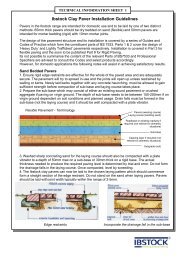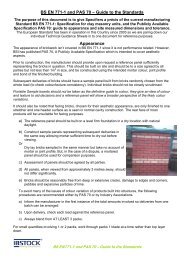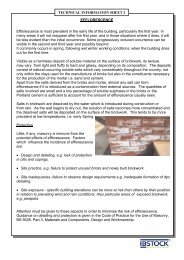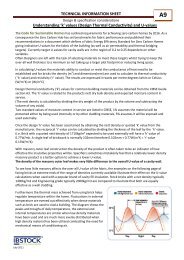EFFLORESCENCE Efflorescence is most prevalent in the ... - Ibstock
EFFLORESCENCE Efflorescence is most prevalent in the ... - Ibstock
EFFLORESCENCE Efflorescence is most prevalent in the ... - Ibstock
You also want an ePaper? Increase the reach of your titles
YUMPU automatically turns print PDFs into web optimized ePapers that Google loves.
TECHNICAL INFORMATION SHEET 2<br />
Attention must <strong>the</strong>refore be given to <strong>the</strong>se aspects <strong>in</strong> order to m<strong>in</strong>im<strong>is</strong>e <strong>the</strong> r<strong>is</strong>k of<br />
efflorescence. Guidance on detail<strong>in</strong>g and protection <strong>is</strong> given <strong>in</strong> <strong>the</strong> Code of Practice for <strong>the</strong><br />
Use of Masonry, BS 5628, Part 3, Materials and Components, Design and Workmanship.<br />
<strong>Efflorescence</strong> dur<strong>in</strong>g construction can be m<strong>in</strong>im<strong>is</strong>ed by ma<strong>in</strong>ta<strong>in</strong><strong>in</strong>g a high standard of<br />
workmanship. Items for particular consideration <strong>in</strong>clude <strong>the</strong> follow<strong>in</strong>g:<br />
Bricks should be stacked onto, a clean, firm level surface. They should be protected from<br />
ra<strong>in</strong>, mud splashes, etc. by cover<strong>in</strong>g with waterproof covers.<br />
Remove <strong>the</strong> scaffold<strong>in</strong>g boards closest to <strong>the</strong> brickwork at all <strong>in</strong>terruptions to construction.<br />
Newly erected masonry should be covered to protect cavities and stop masonry becom<strong>in</strong>g<br />
saturated. Unless <strong>in</strong>structed, <strong>the</strong> method of "dipp<strong>in</strong>g" bricks prior to lay<strong>in</strong>g should be<br />
avoided.<br />
Equally important <strong>is</strong> <strong>the</strong> <strong>in</strong>corporation of <strong>the</strong> appropriate d.p.c.'s, cop<strong>in</strong>gs and cills at <strong>the</strong><br />
design stage. No amount of good site management can alleviate efflorescence from a<br />
badly designed construction.<br />
Remedial<br />
In consider<strong>in</strong>g remedial treatments, efflorescence should preferably be allowed to<br />
wea<strong>the</strong>r away naturally. Its removal can be accelerated <strong>in</strong> more severely affected<br />
areas by dry-brush<strong>in</strong>g followed by a f<strong>in</strong>e water spray, <strong>the</strong> residue be<strong>in</strong>g collected and<br />
removed so that it does not re-enter <strong>the</strong> brickwork at a lower level.<br />
The use of a silicone treatment should be avoided s<strong>in</strong>ce th<strong>is</strong> can result <strong>in</strong> more<br />
permanent problems.<br />
The majority of efflorescence compla<strong>in</strong>ts relate to new brickwork. Recurrent efflorescence<br />
on older establ<strong>is</strong>hed brickwork can often be taken as an <strong>in</strong>dication that water <strong>is</strong> enter<strong>in</strong>g <strong>the</strong><br />
masonry as a result of failure of wea<strong>the</strong>r<strong>in</strong>g and o<strong>the</strong>r protective measures, e.g. faulty<br />
gutters.<br />
Amendment No 1 to BS 3921:1985 (effective 15 December 1995) removed reference to all<br />
efflorescence categories due to <strong>in</strong>cons<strong>is</strong>tency of results from <strong>the</strong> test method.<br />
For fur<strong>the</strong>r <strong>in</strong>formation and advice regard<strong>in</strong>g th<strong>is</strong> topic please contact <strong>Ibstock</strong> Brick Limited<br />
on 0870 903 4017.<br />
Issue 5, April 2004
















